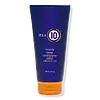What's inside
What's inside
 Key Ingredients
Key Ingredients

 Benefits
Benefits

 Concerns
Concerns

 Ingredients Side-by-side
Ingredients Side-by-side

Water
Skin ConditioningCetearyl Alcohol
EmollientAmodimethicone
Behentrimonium Chloride
PreservativeCetyl Esters
EmollientIsopropyl Alcohol
SolventMentha Arvensis Leaf Oil
MaskingPhenoxyethanol
PreservativeParfum
MaskingTrideceth-6
EmulsifyingHelianthus Annuus Seed Oil
EmollientGlycine Soja Oil
EmollientTocopherol
AntioxidantPanthenol
Skin ConditioningButyrospermum Parkii Butter
Skin ConditioningCetrimonium Chloride
AntimicrobialButylene Glycol
HumectantMenthol
MaskingSimmondsia Chinensis Butter
Skin ConditioningLimonene
PerfumingHelianthus Annuus Seed Extract
Skin ConditioningHydrolyzed Vegetable Protein Pg-Propyl Silanetriol
Skin ConditioningChlorhexidine Dihydrochloride
AntimicrobialCamellia Sinensis Leaf Extract
AntimicrobialRosmarinic Acid
AntioxidantRosmarinus Officinalis Leaf Extract
AntimicrobialSalvia Officinalis Oil
MaskingSalvia Officinalis Leaf Extract
CleansingHydrolyzed Soy Protein
HumectantBenzophenone-4
UV AbsorberLinalool
PerfumingPentylene Glycol
Skin ConditioningWheat Amino Acids
Skin ConditioningSodium Chloride
MaskingMentha Piperita Extract
CleansingAscorbic Acid
AntioxidantPotassium Sorbate
PreservativeDisodium EDTA
Water, Cetearyl Alcohol, Amodimethicone, Behentrimonium Chloride, Cetyl Esters, Isopropyl Alcohol, Mentha Arvensis Leaf Oil, Phenoxyethanol, Parfum, Trideceth-6, Helianthus Annuus Seed Oil, Glycine Soja Oil, Tocopherol, Panthenol, Butyrospermum Parkii Butter, Cetrimonium Chloride, Butylene Glycol, Menthol, Simmondsia Chinensis Butter, Limonene, Helianthus Annuus Seed Extract, Hydrolyzed Vegetable Protein Pg-Propyl Silanetriol, Chlorhexidine Dihydrochloride, Camellia Sinensis Leaf Extract, Rosmarinic Acid, Rosmarinus Officinalis Leaf Extract, Salvia Officinalis Oil, Salvia Officinalis Leaf Extract, Hydrolyzed Soy Protein, Benzophenone-4, Linalool, Pentylene Glycol, Wheat Amino Acids, Sodium Chloride, Mentha Piperita Extract, Ascorbic Acid, Potassium Sorbate, Disodium EDTA
Parfum
MaskingRetinyl Palmitate
Skin ConditioningTocopheryl Acetate
AntioxidantHydrolyzed Collagen
EmollientAloe Barbadensis Leaf Juice
Skin ConditioningPrunus Amygdalus Dulcis Protein
Skin ConditioningHelianthus Annuus Seed Extract
Skin ConditioningCamellia Sinensis Seed Extract
HumectantMethyl Gluceth-20
HumectantDimethicone
EmollientHydrogenated Apricot Kernel Oil
Skin ConditioningSodium Ascorbyl Phosphate
AntioxidantKeratin Amino Acids
Skin ConditioningLinum Usitatissimum Seed Flour
AbrasiveWine Extract
AntioxidantAvena Sativa Kernel Extract
AbrasiveButylene Glycol
HumectantCitric Acid
BufferingSodium Chloride
MaskingPropylene Glycol
HumectantMethylethanolamine
BufferingLinalool
PerfumingHexyl Cinnamal
PerfumingHydroxyisohexyl 3-Cyclohexene Carboxaldehyde
MaskingCadinene
PerfumingBenzyl Benzoate
AntimicrobialParfum, Retinyl Palmitate, Tocopheryl Acetate, Hydrolyzed Collagen, Aloe Barbadensis Leaf Juice, Prunus Amygdalus Dulcis Protein, Helianthus Annuus Seed Extract, Camellia Sinensis Seed Extract, Methyl Gluceth-20, Dimethicone, Hydrogenated Apricot Kernel Oil, Sodium Ascorbyl Phosphate, Keratin Amino Acids, Linum Usitatissimum Seed Flour, Wine Extract, Avena Sativa Kernel Extract, Butylene Glycol, Citric Acid, Sodium Chloride, Propylene Glycol, Methylethanolamine, Linalool, Hexyl Cinnamal, Hydroxyisohexyl 3-Cyclohexene Carboxaldehyde, Cadinene, Benzyl Benzoate
Ingredients Explained
These ingredients are found in both products.
Ingredients higher up in an ingredient list are typically present in a larger amount.
Butylene Glycol (or BG) is used within cosmetic products for a few different reasons:
Overall, Butylene Glycol is a safe and well-rounded ingredient that works well with other ingredients.
Though this ingredient works well with most skin types, some people with sensitive skin may experience a reaction such as allergic rashes, closed comedones, or itchiness.
Learn more about Butylene GlycolHelianthus Annuus Seed Extract comes from sunflower seeds.
Sunflower seeds are rich in vitamin E. Studies show sunflowers contain antimicrobial and antioxidant properties.
The fatty acids found in sunflower seeds include (from highest amount to least): linoleic acid, myristic acid, palmitic acid, stearic acid, arachidic acid, oleic acid, and linolenic acid.
These fatty acids hydrate your skin. Emollients create a film on the skin to prevent moisture from escaping.
Learn more about Helianthus Annuus Seed ExtractLinalool is a fragrance and helps add scent to products. It's derived from common plants such as cinnamon, mint, citrus, and lavender.
Like Limonene, this ingredient oxidizes when exposed to air. Oxidized linalool can cause allergies and skin sensitivity.
This ingredient has a scent that is floral, spicy tropical, and citrus-like.
Learn more about LinaloolParfum is a catch-all term for an ingredient or more that is used to give a scent to products.
Also called "fragrance", this ingredient can be a blend of hundreds of chemicals or plant oils. This means every product with "fragrance" or "parfum" in the ingredients list is a different mixture.
For instance, Habanolide is a proprietary trade name for a specific aroma chemical. When used as a fragrance ingredient in cosmetics, most aroma chemicals fall under the broad labeling category of “FRAGRANCE” or “PARFUM” according to EU and US regulations.
The term 'parfum' or 'fragrance' is not regulated in many countries. In many cases, it is up to the brand to define this term.
For instance, many brands choose to label themselves as "fragrance-free" because they are not using synthetic fragrances. However, their products may still contain ingredients such as essential oils that are considered a fragrance by INCI standards.
One example is Calendula flower extract. Calendula is an essential oil that still imparts a scent or 'fragrance'.
Depending on the blend, the ingredients in the mixture can cause allergies and sensitivities on the skin. Some ingredients that are known EU allergens include linalool and citronellol.
Parfum can also be used to mask or cover an unpleasant scent.
The bottom line is: not all fragrances/parfum/ingredients are created equally. If you are worried about fragrances, we recommend taking a closer look at an ingredient. And of course, we always recommend speaking with a professional.
Learn more about ParfumChances are, you eat sodium chloride every day. Sodium Chloride is also known as table salt.
This ingredient has many purposes in skincare: thickener, emulsifier, and exfoliator.
You'll most likely find this ingredient in cleansers where it is used to create a gel-like texture. As an emulsifier, it also prevents ingredients from separating.
There is much debate on whether this ingredient is comedogenic. The short answer - comedogenic ratings don't tell the whole story. Learn more about comegodenic ratings here.
The concensus about this ingredient causing acne seems to be divided. Research is needed to understand if this ingredient does cause acne.
Scrubs may use salt as the primary exfoliating ingredient.
Learn more about Sodium Chloride